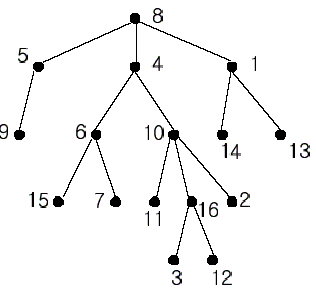又是深夜更新博客 。。。为的是写一下今天学的LCA(Least Common Ancestors),也就是最近祖先问题。。。最近祖先也就是离根结点最远的祖先。。。
。。。为的是写一下今天学的LCA(Least Common Ancestors),也就是最近祖先问题。。。最近祖先也就是离根结点最远的祖先。。。
有两种算法,一种是离线算法:Tarjan算法(突然觉得这个人提出了好多算法。。。),第二种是在线算法:ST算法 。
由于今天只看了Tarjan算法、它的一些拓展和RMQ,并没有写ST的模板,再加上没有数据结构的基础。。到现在还不能透彻地了解树、二叉树和各种什么什么的二叉树
这里先贴一下大神的链接,http://dongxicheng.org/structure/lca-rmq/(后面的算法介绍也就用大神的了/。。)接下去先写 关于Tarjan算法。。(其实我觉得Tarjan算法更好一
点。。。)
Tarjan
所谓离线算法,是指首先读入所有的询问(求一次LCA叫做一次询问),然后重新组织查询处理顺序以便得到更高效的处理方法。Tarjan算法是一个常见的用于解决LCA问题的离线算法,它结合了深度优先遍历和并查集,整个算法为线性处理时间。
Tarjan算法是基于并查集的,利用并查集优越的时空复杂度,可以实现LCA问题的O(n+Q)算法,这里Q表示询问 的次数。更多关于并查集的资料,可阅读这篇文章:《数据结构之并查集》。
同上一个算法一样,Tarjan算法也要用到深度优先搜索,算法大体流程如下:对于新搜索到的一个结点,首先创建由这个结点构成的集合,再对当前结点的每一个子树进行搜索,每搜索完一棵子树,则可确定子树内的LCA询问都已解决。其他的LCA询问的结果必然在这个子树之外,这时把子树所形成的集合与当前结点的集合合并,并将当前结点设为这个集合的祖先。之后继续搜索下一棵子树,直到当前结点的所有子树搜索完。这时把当前结点也设为已被检查过的,同时可以处理有关当前结点的LCA询问,如果有一个从当前结点到结点v的询问,且v已被检查过,则由于进行的是深度优先搜索,当前结点与v的最近公共祖先一定还没有被检查,而这个最近公共祖先的包涵v的子树一定已经搜索过了,那么这个最近公共祖先一定是v所在集合的祖先。
【举例说明】 
根据实现算法可以看出,只有当某一棵子树全部遍历处理完成后,才将该子树的根节点标记为黑色(初始化是白色),假设程序按上面的树形结构进行遍历,首先从节点1开始,然后递归处理根为2的子树,当子树2处理完毕后,节点2, 5, 6均为黑色;接着要回溯处理3子树,首先被染黑的是节点7(因为节点7作为叶子不用深搜,直接处理),接着节点7就会查看所有询问(7, x)的节点对,假如存在(7, 5),因为节点5已经被染黑,所以就可以断定(7, 5)的最近公共祖先就是find(5).ancestor,即节点1(因为2子树处理完毕后,子树2和节点1进行了union,find(5)返回了合并后的树的根1,此时树根的ancestor的值就是1)。有人会问如果没有(7, 5),而是有(5, 7)询问对怎么处理呢? 我们可以在程序初始化的时候做个技巧,将询问对(a, b)和(b, a)全部存储,这样就能保证完整性。
我觉得上面的文字写的真是太赞了! 下面的模板代码是我自己写的
下面的模板代码是我自己写的
/***************************************************************************************************
查询过程始终是框定在某一棵子树里面的,所以只有两种情况:1.另外一点没有被遍历过,
那么等待下次回溯的时候回溯到要查询的另外一点2.另外一点已经被遍历过,那么就输出
另外一点的祖先节点,而这个祖先节点必定为他们两者的最近祖先节点(原因很简单,这
是dfs,对于这个祖先节点,必然先遍历完它的左子树再遍历它的右子树,此时他的左子树
的所有点都会存有这个祖先节点
******************************************************************************************************/
#include <cstdio>
#include <string.h>
#include <vector>
using namespace std;
int const MAX = 10000;
vector<int> G[MAX];
int fa[MAX];
int vis[MAX];//判断某点是不是回溯到的,如果是回溯到的就进行查询操作
int n, q1, q2;
void init()
{
for(int i = 1; i <= n; i++){
vis[i] = 0;
G[i].clear();
}
}
int find(int x)//寻找祖先节点
{
while(x != fa[x])
x = fa[x];
return x;
}
void tarjan(int u)
{
vis[u] = 1;
fa[u] = u;
for(int i = 0; i < G[u].size(); i++){
int v = G[u][i];
if(!vis[v]){
tarjan(v);
fa[v] = u;
}
}
if(u == q1 || u == q2){//这里假设查询q1和q2两点
if(u == q1 && vis[q2])
ans = find(q2);
else if(u == q2 && vis[q1])
ans = find(q1);
}
}
经典例题
http://poj.org/problem?id=1330
Nearest Common Ancestors
| Time Limit: 1000MS | Memory Limit: 10000K | |
| Total Submissions: 24999 | Accepted: 12984 |
Description

In the figure, each node is labeled with an integer from {1, 2,...,16}. Node 8 is the root of the tree. Node x is an ancestor of node y if node x is in the path between the root and node y. For example, node 4 is an ancestor of node 16. Node 10 is also an ancestor of node 16. As a matter of fact, nodes 8, 4, 10, and 16 are the ancestors of node 16. Remember that a node is an ancestor of itself. Nodes 8, 4, 6, and 7 are the ancestors of node 7. A node x is called a common ancestor of two different nodes y and z if node x is an ancestor of node y and an ancestor of node z. Thus, nodes 8 and 4 are the common ancestors of nodes 16 and 7. A node x is called the nearest common ancestor of nodes y and z if x is a common ancestor of y and z and nearest to y and z among their common ancestors. Hence, the nearest common ancestor of nodes 16 and 7 is node 4. Node 4 is nearer to nodes 16 and 7 than node 8 is.
For other examples, the nearest common ancestor of nodes 2 and 3 is node 10, the nearest common ancestor of nodes 6 and 13 is node 8, and the nearest common ancestor of nodes 4 and 12 is node 4. In the last example, if y is an ancestor of z, then the nearest common ancestor of y and z is y.
Write a program that finds the nearest common ancestor of two distinct nodes in a tree.
Input
Output
Sample Input
2 16 1 14 8 5 10 16 5 9 4 6 8 4 4 10 1 13 6 15 10 11 6 7 10 2 16 3 8 1 16 12 16 7 5 2 3 3 4 3 1 1 5 3 5
Sample Output
4 3
这题唯一要注意的是:入度为0的根节点不确定,所以要用in数组来判断
#include <cstdio>
#include <vector>
#include <string.h>
using namespace std;
int const MAX = 10005;
vector<int> G[MAX];
int fa[MAX];
int in[MAX], vis[MAX];
int n;
int q1, q2, ans;
int find(int x)
{
while(x != fa[x])
x = fa[x];
return x;
}
void tarjan(int u)
{
vis[u] = 1;
fa[u] = u;
for(int i = 0; i < G[u].size(); i++){
int v = G[u][i];
if(!vis[v]){
tarjan(v);
fa[v] = u;
}
}
if(u == q1 || u == q2){
if(u == q1 && vis[q2])
ans = find(q2);
else if(u == q2 && vis[q1])
ans = find(q1);
}
}
int main()
{
int cases;
scanf("%d", &cases);
while(cases--){
memset(vis, 0, sizeof(vis));
memset(in, 0, sizeof(in));
scanf("%d", &n);
for(int i = 1; i <= n; i++)
G[i].clear();
for(int i = 1; i < n; i++){
int u, v;
scanf("%d %d", &u, &v);
in[v]++;
G[u].push_back(v);
G[v].push_back(u);
}
scanf("%d %d", &q1, &q2);
for(int i = 1; i < n; i++){
if(!in[i]){
tarjan(i);
break;
}
}
printf("%d\n", ans);
}
return 0;
}
未完待续。。。





 本文深入讲解了Tarjan算法,一种解决最近公共祖先(LCA)问题的高效离线算法。通过结合深度优先遍历与并查集,实现了线性的处理时间。文章提供了详细的算法流程与示例代码。
本文深入讲解了Tarjan算法,一种解决最近公共祖先(LCA)问题的高效离线算法。通过结合深度优先遍历与并查集,实现了线性的处理时间。文章提供了详细的算法流程与示例代码。
















 1004
1004

 被折叠的 条评论
为什么被折叠?
被折叠的 条评论
为什么被折叠?








